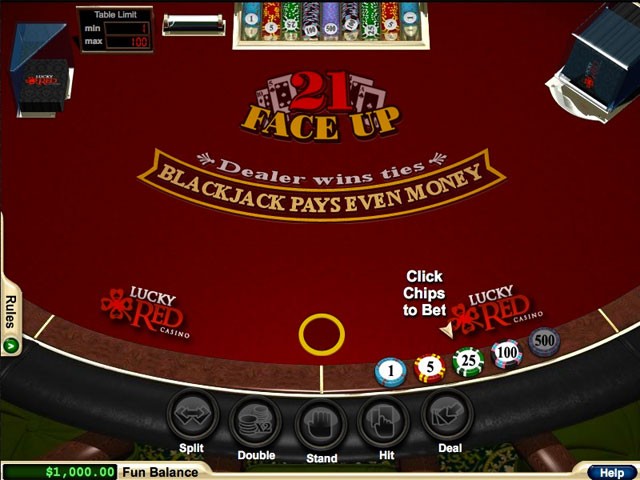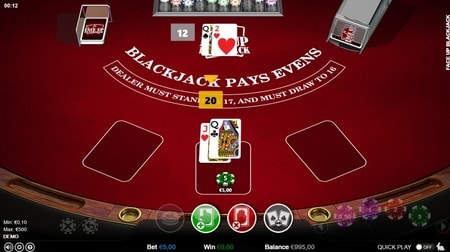Face Up Blackjack

Face Up Blackjack
Double Exposure Blackjack (also known as ZweikartenspielGerman: 'Two card game') is a variant of the casino game blackjack in which the dealer receives two cards face-up in part of the initial deal. Knowing the dealer's hand provides significant information to the player. To maintain the house edge, the payout when the player receives a natural blackjack is reduced to even money from 3:2, and players lose their bets when their hand is tied with the dealer. In addition, with both dealers' cards exposed at the outset, players cannot buy insurance or surrender their hand.

Blackjack Rules.Note: The card suits are irrelevant in Blackjack. Players place bets by putting the desired number of chips in the circle in front of their seat. The dealer deals two cards face up to each player. The dealer receives one card face up and one face down. Sometimes the game goes by other names like 'Dealer Disclosure' or 'Face Up 21.' Tropicana, Claridge, Taj Majal (Atlantic City): 8 decks, dealer stands on soft 17, double only on hard 9-11 and soft 19-20, double after a split allowed, tied blackjack wins, split only once. House edge of 0.66%. How to play face-up blackjack correctly. The game involves 6 full decks, of which one is formed, with the size of 312 cards. It is placed in the dispensing shoe, and then trimmed with a dividing card. If, after the deal, one of the participants of the party has an ace and a card with ten eyes, then this situation is called “blackjack”. If they have blackjack on their first hand, pay back their bet with a 3:2 bonus (for example, a $20 bet receives $30, as well as the return of their original bet.) Before players take additional cards, they can double down. In this case, deal them a new card face up after they have added their extra bet. Classic blackjack but with the added advantage of the cards being dealt Face up! When the cards are dealt, you see both of your cards AND both of the Dealer’s cards. Thus the name: Face Up. Being able to see the Dealer’s full hand presents some unique rules and challenges.
Other rules changes also exist to the detriment of players. Certain tables restrict doubling down and splitting, and do not allow doubles after splits.
The game was proposed by Richard A. Epstein in 1977, and first appeared at Vegas World in 1979 with rule changes that favored the house.[1][2][3]
The basic strategy for this game is different, both because the player can see dealer cards 11 to 20 and because the player loses all ties except blackjacks. For examples, two ten-value cards are split whenever the dealer has 13 through 16, and a hard 19 must be hit if the dealer has a 20.
References[edit]
- ^Epstein, Richard. The theory of gambling and statistical logic. Academic Press. ISBN978-0123749406.
- ^Snyder, Arnold. Big book of blackjack. Cardoza Publishing. p. 228. ISBN978-1580423151.
- ^'Modern Blackjack page 32'. Qfit.com. Retrieved 2009-09-03.
Face Up 21 Blackjack Review
- Number of decks: 6
- Blackjack payout: 1:1
- Dealer’s forced move: Stands on Hard 17
- Dealer’s first card: 2 up
- Split: Yes
- Re-Split: No
- Split Aces: Yes – no draw
- Double Down: 9/10/A
- Surrender: No
- Insurance: No
In Face Up 21, the dealer always hits on soft 17. Interestingly, when the dealer is forced to stand (any Hard hand of 17 or more), the game takes over for you, and automatically hits for you until you win or bust.
Card Game Blackjack Rules
You can split any pair for a new bet equal to your ante, and can continue to hit on each hand, unless the cards split were aces, in which case each hand just gets one more card then you must stand.
You can double down on Hard totals of 9, 10, and 11, and can double down after a split. Because you can see the dealer’s first two cards, insurance is not available, nor can you surrender in this game. Dealer wins all ties.
Face Up Blackjack Rules
Your Ante bet when playing Face Up 21 has to be at least 1, and can be no more than 250 USD/GBP/Euro. There are four different chips – 1, 5, 25, and 100 – that you can use to place your bet. Because this is a game of Face Up, where the Dealer’s hand is exposed, blackjack pays even money in this game, at 1:1. In fact, all winning hands pay at 1:1, so you can always know how much you will win when you place your bet!
When you first load up Face Up 21, you will probably notice how clean the interface is. All the extra elements, like card shoes, chip trays, and the buttons you use to play, are clustered neatly around the edges of the table, leaving the center open and unobstructed for the cards to go.
Once the game starts, things move quickly and smoothly, and even on older computers the game runs great. While there are some animations and card flourishes thrown in, they fly on by, never getting in the way of the game at all.
Watch the dealer’s cards! This might seem obvious, but it is easy to get into a habit when playing blackjack on a computer of just clicking away based on what your hand is, without glancing up to see what the dealer has got. This is especially important in Face Up 21, since you can see both of the dealer’s cards. If the dealer has a mid-high total, be careful! He might get to 21 before you do!
Face Up Blackjack Rules
Face Up 21 from RTG is an excellent game in itself, and as a Face Up blackjack game, it hovers high above the rest. The graphics achieve a high level of realism, and when you combine this with the smooth, quick gameplay and subtle sound effects, you get very close to a real live casino blackjack experience. How much can you win before going bust?